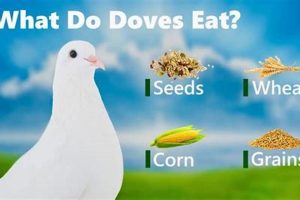Selecting optimal nourishment for young canines of the Bulldog breed involves careful consideration of their unique physiological needs. These needs stem from their breed-specific traits, including a brachycephalic (short-nosed) structure and a predisposition to certain health conditions. Providing a diet that caters to these factors is paramount for healthy growth and development during puppyhood.
Appropriate dietary choices offer numerous advantages, such as supporting skeletal development, promoting healthy digestion, and minimizing the risk of allergies or sensitivities common in this breed. Historically, reliance on generic puppy food formulations often proved inadequate, leading to nutritional deficiencies and related health problems. A more informed approach to canine nutrition has highlighted the necessity for breed-specific dietary considerations.
Consequently, the following sections will delve into specific dietary requirements for young Bulldogs, outlining key ingredients, optimal nutrient ratios, and factors to consider when choosing commercial or homemade feeding options. Furthermore, it will address potential challenges related to feeding this breed and provide practical guidance for ensuring adequate nutrition throughout their critical developmental stages.
Guidance for Bulldog Puppy Nutrition
The proper selection and administration of nutrients significantly impact the healthy development of Bulldog puppies. Adherence to the following guidelines can aid in supporting their unique physiological needs and mitigating potential health risks.
Tip 1: Prioritize Protein Sources: Diets should feature high-quality animal protein sources like chicken, lamb, or fish to support muscle development. Protein content should be within the recommended range for puppies, typically 22-32% on a dry matter basis. Avoid foods with excessive plant-based protein, as these are often less digestible for canines.
Tip 2: Manage Fat Content Carefully: Moderate fat levels, around 12-18%, are beneficial for energy and skin health. However, excessive fat intake can contribute to obesity, a common concern in Bulldogs. Select foods with omega-3 and omega-6 fatty acids to support coat health and reduce inflammation.
Tip 3: Monitor Calcium and Phosphorus Levels: Precise calcium and phosphorus ratios are critical for proper bone and joint development. Imbalances can lead to skeletal problems. Consult with a veterinarian to determine the optimal levels for your Bulldog puppy, as excess calcium supplementation can be detrimental.
Tip 4: Incorporate Fiber Sources: Adequate fiber, such as beet pulp or pumpkin, promotes healthy digestion and regular bowel movements. Bulldogs are prone to digestive sensitivities, making fiber inclusion essential. Avoid foods with excessive amounts of insoluble fiber, which can hinder nutrient absorption.
Tip 5: Choose Smaller Kibble Size: Bulldog puppies often have difficulty consuming large kibble pieces due to their brachycephalic anatomy. Opt for smaller, easily manageable kibble to prevent choking or discomfort during feeding. Soaking kibble in water can further aid in digestion and hydration, particularly for very young puppies.
Tip 6: Adhere to Scheduled Feeding Times: Establish consistent feeding times to regulate digestion and prevent overeating. Free-feeding is generally discouraged, as it can contribute to weight gain. Divide the daily food allowance into multiple small meals to reduce the risk of bloat, a life-threatening condition in Bulldogs.
Tip 7: Monitor for Food Sensitivities: Bulldogs are predisposed to food allergies and sensitivities. Watch for signs like itching, skin irritation, or digestive upset. If symptoms arise, consider a limited-ingredient diet formulated with novel protein sources, such as duck or venison, to identify potential allergens.
Consistently adhering to these nutritional guidelines provides a solid foundation for a Bulldog puppy’s health. Regular veterinary check-ups, including weight and body condition assessment, are essential for adjusting dietary strategies as the puppy grows. Prioritizing high-quality ingredients and mindful feeding practices supports optimal growth and reduces the risk of breed-specific health challenges.
The subsequent sections will address specific commercial food options suitable for Bulldogs and offer insights into homemade diet considerations, providing a comprehensive guide to canine nutrition for this unique breed.
1. Protein Source Quality
Protein source quality represents a critical element when determining optimal nourishment for Bulldog puppies. This factor significantly influences muscle development, immune function, and overall growth during their formative stages. The digestibility and amino acid profile of the protein source directly impact the puppy’s ability to utilize nutrients effectively.
- Amino Acid Profile Completeness
A complete amino acid profile, containing all essential amino acids in appropriate ratios, is vital. Protein sources such as chicken, beef, lamb, and fish naturally offer complete profiles. Incomplete protein sources, often derived from plants, may require supplementation or careful combination to meet the puppys needs. Insufficient essential amino acids can lead to stunted growth and compromised immune response.
- Digestibility and Bioavailability
The degree to which a protein source is digestible determines the amount of amino acids available for absorption. Highly digestible protein sources, such as egg and whey, are generally preferable. Factors affecting digestibility include processing methods and the presence of anti-nutritional factors. Poor digestibility results in nutrient wastage and potential digestive upset.
- Source Authenticity and Purity
The origin and processing of the protein source are crucial. Reputable manufacturers utilize high-quality ingredients with minimal processing. Protein meals, rendered byproducts, or ingredients with questionable origins are less desirable due to potential contamination or reduced nutritional value. Transparency in ingredient sourcing is a hallmark of quality.
- Allergenic Potential
Certain protein sources, like beef or chicken, are more likely to trigger allergic reactions in sensitive dogs. Novel protein sources, such as duck, venison, or fish, are often recommended for puppies with suspected food sensitivities. Identifying and eliminating allergenic proteins is essential for maintaining digestive health and preventing skin issues.
In conclusion, the quality of the protein source is a cornerstone in selecting appropriate nourishment for Bulldog puppies. Consideration of the amino acid profile, digestibility, source authenticity, and allergenic potential facilitates informed decisions. Prioritizing high-quality, easily digestible protein sources with complete amino acid profiles minimizes health risks and supports optimal growth and development.
2. Fatty Acid Balance
Fatty acid balance is a critical consideration in the formulation of optimal canine diets, especially for Bulldog puppies. The precise ratio of different fatty acids profoundly influences various physiological processes, impacting skin health, immune function, and cognitive development. Therefore, selecting a puppy food with an appropriately balanced fatty acid profile is essential for the well-being of this breed.
- Omega-6 to Omega-3 Ratio
The ratio of omega-6 to omega-3 fatty acids is paramount. An imbalance, particularly an excess of omega-6, can promote inflammation. While omega-6 fatty acids are essential for skin barrier function, excessive amounts can exacerbate inflammatory conditions. Ideally, a ratio of 5:1 or lower is recommended to support anti-inflammatory processes and overall health in Bulldog puppies. For example, diets rich in linoleic acid (omega-6) and low in EPA/DHA (omega-3) might lead to increased pruritus in predisposed individuals.
- EPA and DHA Content
Eicosapentaenoic acid (EPA) and docosahexaenoic acid (DHA) are omega-3 fatty acids with significant benefits. DHA is crucial for brain and vision development in puppies. EPA possesses anti-inflammatory properties that can alleviate skin allergies and joint discomfort. The inclusion of fish oil or algal oil in puppy food can ensure adequate levels of these essential fatty acids. Deficiency in DHA can impair cognitive function and visual acuity during critical developmental stages.
- Saturated vs. Unsaturated Fats
The proportion of saturated and unsaturated fats also plays a role. Unsaturated fats, including monounsaturated and polyunsaturated fats, are generally considered healthier than saturated fats. Unsaturated fats support cell membrane integrity and hormone production. Excessive saturated fat intake can contribute to elevated cholesterol levels and potential cardiovascular issues. Puppy food formulations should prioritize unsaturated fats from sources like vegetable oils and fish oils.
- Source and Quality of Fats
The source and quality of fats are equally important as the ratios. High-quality sources, such as flaxseed oil, sunflower oil, and fish oil, provide essential fatty acids in a readily bioavailable form. Avoidance of rendered fats or those of questionable origin is crucial. The presence of antioxidants, like vitamin E, helps prevent rancidity and preserves the integrity of the fatty acids. Reputable manufacturers prioritize quality sourcing and rigorous testing to ensure the safety and efficacy of their products.
In summation, the fatty acid balance within canine diets intended for Bulldog puppies constitutes a pivotal aspect of their overall well-being. Appropriate ratios, adequate levels of EPA and DHA, a favorable balance of saturated to unsaturated fats, and high-quality sourcing collectively contribute to optimal skin health, immune function, and cognitive development. These factors should be carefully evaluated when selecting the most appropriate nutritional regimen.
3. Calcium-Phosphorus Ratio
The calcium-phosphorus ratio within canine diets represents a crucial factor influencing skeletal development, particularly in Bulldog puppies. The breed’s predisposition to skeletal abnormalities necessitates meticulous control over this nutritional parameter when selecting optimal food formulations.
- Bone Development and Mineralization
Calcium and phosphorus are essential minerals for bone growth and mineralization. An appropriate ratio, typically ranging from 1:1 to 2:1 (calcium to phosphorus), ensures optimal bone density and strength. Imbalances can lead to skeletal abnormalities, such as hip dysplasia or osteochondrosis dissecans (OCD), prevalent in rapidly growing breeds. For instance, excessive calcium intake during puppyhood can disrupt normal cartilage development, predisposing to joint problems later in life.
- Regulation of Parathyroid Hormone
The calcium-phosphorus balance affects the secretion of parathyroid hormone (PTH), which regulates calcium levels in the blood. When calcium levels are low, PTH stimulates the release of calcium from bones. Chronic imbalances can disrupt this regulatory mechanism, leading to secondary hyperparathyroidism and subsequent skeletal demineralization. Therefore, maintaining the correct ratio is imperative for hormonal balance and skeletal integrity.
- Absorption and Bioavailability
The absorption and bioavailability of calcium and phosphorus are influenced by several factors, including the presence of vitamin D and other dietary components. Vitamin D enhances calcium absorption in the intestine. High levels of phytates or oxalates, found in certain plant-based ingredients, can inhibit calcium absorption. Choosing puppy food with readily bioavailable calcium and phosphorus sources is essential to ensure adequate mineral uptake.
- Breed-Specific Considerations
Bulldog puppies exhibit a unique growth pattern and a predisposition to certain skeletal conditions. As such, their dietary calcium and phosphorus requirements may differ from those of other breeds. Consulting with a veterinarian or canine nutritionist to determine the optimal ratio and daily intake is highly recommended. Individual variations in growth rate and activity level may necessitate adjustments to the dietary plan.
The careful management of the calcium-phosphorus ratio is fundamental for supporting healthy skeletal development in Bulldog puppies. Selection of a commercially prepared puppy food with a guaranteed analysis reflecting appropriate mineral levels, or formulation of a balanced homemade diet under veterinary supervision, contributes significantly to minimizing the risk of skeletal abnormalities and promoting long-term orthopedic health.
4. Fiber Content Digestibility
Fiber content digestibility represents a significant consideration in the selection of appropriate nourishment for Bulldog puppies. Given the breed’s predisposition to digestive sensitivities and potential for obesity, the type and digestibility of fiber included in their diet directly impact gastrointestinal health and weight management.
- Impact on Gut Microbiota
Digestible fibers, such as beet pulp and fructooligosaccharides (FOS), serve as prebiotics, promoting the growth of beneficial gut bacteria. These bacteria ferment the fiber, producing short-chain fatty acids (SCFAs) that nourish the colonocytes and support intestinal health. An appropriate balance of gut microbiota is essential for efficient digestion, nutrient absorption, and immune system regulation. In contrast, poorly digestible fibers may disrupt the microbial balance, leading to digestive upset or promoting the growth of less desirable bacterial species.
- Regulation of Bowel Movements
The type and amount of fiber influence stool consistency and regularity. Moderately fermentable fibers contribute to stool bulk and promote regular bowel movements, preventing constipation, a common issue in Bulldogs. However, excessive amounts of poorly digestible fibers can lead to diarrhea. A balanced approach, incorporating both soluble and insoluble fiber sources, is crucial for maintaining optimal bowel function. For example, diets with high levels of cellulose may increase fecal volume without providing significant prebiotic benefits.
- Effect on Glycemic Control
Soluble fibers, such as pectin and guar gum, can slow gastric emptying and glucose absorption, contributing to improved glycemic control. This effect is particularly beneficial for overweight or obese Bulldog puppies, as it helps regulate blood sugar levels and reduce insulin spikes. Stable blood glucose levels can aid in weight management and reduce the risk of developing diabetes. Diets lacking sufficient soluble fiber may result in rapid glucose absorption and contribute to weight gain.
- Influence on Nutrient Absorption
Highly digestible fibers generally do not significantly hinder nutrient absorption. However, excessive amounts of poorly digestible fibers can interfere with the absorption of essential nutrients, such as vitamins and minerals. This is due to the fiber binding to these nutrients and preventing their uptake in the small intestine. Selecting fiber sources with high digestibility minimizes the risk of nutrient malabsorption and ensures that the puppy receives the full nutritional benefits of its diet. Examples of poorly digestible fiber binding to nutrients include high concentrations of lignin or poorly processed cellulose.
In conclusion, the digestibility of fiber is a key determinant in selecting optimal nourishment for Bulldog puppies. Incorporating moderately fermentable fibers that promote gut health, regulate bowel movements, improve glycemic control, and minimize nutrient malabsorption supports overall well-being and reduces the risk of digestive complications. These fiber characteristics align the best dog food with healthy physiological function.
5. Kibble Size Suitability
Kibble size suitability constitutes a significant determinant in the selection of optimal nourishment for Bulldog puppies. This consideration stems from their brachycephalic anatomy, characterized by a shortened muzzle and compressed facial features, which can impede efficient prehension and mastication of standard-sized kibble. Inadequate kibble size may lead to inefficient food consumption, choking hazards, and digestive discomfort, ultimately impacting the overall health and well-being of the puppy. Therefore, kibble size suitability directly affects the formulation and selection of the best dietary options for this breed.
Bulldog puppies often exhibit difficulties in grasping and chewing larger kibble pieces due to their unique oral structure. Oversized kibble can result in the puppy attempting to swallow the food whole, increasing the risk of esophageal obstruction or regurgitation. Conversely, appropriately sized kibble, generally smaller in diameter and specifically designed for small breeds or puppies, facilitates easier prehension, thorough chewing, and efficient digestion. Some manufacturers now offer breed-specific formulas featuring kibble shapes and sizes optimized for brachycephalic breeds, recognizing the importance of this factor. A failure to consider kibble dimensions during diet selection can negate other nutritional benefits, as the puppy may not effectively consume or digest the food.
In summary, kibble size suitability represents an indispensable aspect of selecting the best sustenance for Bulldog puppies. Addressing potential challenges related to their unique anatomy through appropriate kibble dimensions supports efficient food consumption, reduces choking hazards, and promotes optimal digestive health. Careful consideration of this factor, in conjunction with other nutritional requirements, contributes significantly to ensuring the puppy’s long-term health and well-being. The selection process is not simply about nutritional content, but also about practical applicability for the breed’s physiological traits.
6. Ingredient Sensitivity Control
Ingredient sensitivity control represents a pivotal aspect of selecting suitable sustenance for Bulldog puppies. The breed exhibits a predisposition to various food sensitivities and allergies, necessitating careful scrutiny of dietary components. These sensitivities often manifest as dermatological or gastrointestinal issues, impacting the puppy’s well-being and necessitating specialized dietary management. Therefore, the ability to effectively control and minimize potential allergenic ingredients forms an integral part of defining optimal nutrition for Bulldog puppies.
The connection between ingredient sensitivity control and appropriate nutrition manifests through the selection of limited-ingredient diets or novel protein sources. Limited-ingredient diets, characterized by a reduced number of components, simplify the process of identifying potential allergens. For instance, a formula excluding common allergens such as beef, chicken, and wheat, and relying instead on novel proteins like duck or venison, can mitigate allergic reactions in sensitive individuals. Novel protein sources, less frequently encountered in canine diets, reduce the likelihood of eliciting an immune response. The practical significance lies in the alleviation of clinical signs, such as pruritus, dermatitis, and gastrointestinal distress, improving the puppy’s quality of life. Proper ingredient control prevents the activation of the immune system, which occurs when certain ingredients get recognized as threatening, therefore the health of the puppies is maintained.
Effective ingredient sensitivity control in Bulldog puppies involves careful label reading, ingredient awareness, and observation of the puppy’s response to the diet. Owners must be diligent in identifying potential allergens and monitoring for any adverse reactions. Collaboration with a veterinarian or canine nutritionist is essential for developing a personalized feeding plan that addresses specific sensitivities. Addressing ingredient sensitivities is not merely a therapeutic intervention; it also plays a pivotal role in preventive care, minimizing the long-term health implications associated with chronic allergic conditions. This careful and planned approach makes the best dog food for bulldog puppies the proper solution to improve health and reduce the risk of developing allergies.
Frequently Asked Questions
This section addresses common inquiries regarding appropriate dietary choices for Bulldog puppies, aiming to clarify essential aspects of their nutritional needs and dispel prevalent misconceptions.
Question 1: Are grain-free diets inherently superior for Bulldog puppies?
Grain-free diets are not universally superior. While beneficial for puppies with grain sensitivities, they are unnecessary for those without allergies. Focus on overall nutritional balance and ingredient quality, rather than simply eliminating grains. Evaluate the specific nutrient profile and consult with a veterinarian before opting for grain-free formulas.
Question 2: Is homemade food always the best option for Bulldog puppies?
Homemade food can be a viable option, but it requires meticulous planning and adherence to established nutritional guidelines. Inadequate formulation can result in deficiencies and health complications. Consultation with a veterinary nutritionist is essential to ensure that the diet meets all the puppy’s requirements. Commercial foods are often formulated for balanced nutrition.
Question 3: How frequently should a Bulldog puppy be fed?
Bulldog puppies require multiple small meals throughout the day. Frequent feeding prevents hypoglycemia and reduces the risk of bloat. Typically, four meals per day are appropriate until six months of age, followed by a transition to two meals daily. Monitor weight and adjust portion sizes accordingly.
Question 4: Is it necessary to supplement a Bulldog puppy’s diet with vitamins and minerals?
Supplementation is generally unnecessary when feeding a high-quality, commercially prepared puppy food. Excessive supplementation can disrupt the delicate balance of nutrients and potentially cause harm. Unless specifically recommended by a veterinarian to address a diagnosed deficiency, supplementation should be avoided.
Question 5: How can one identify a food allergy in a Bulldog puppy?
Food allergies often manifest as skin irritation, itching, ear infections, or gastrointestinal upset. Diagnosing a food allergy typically involves an elimination diet trial, where all previously consumed ingredients are removed and replaced with a novel protein source. The guidance of a veterinarian is essential for accurate diagnosis and management.
Question 6: How does kibble size influence a Bulldog puppy’s eating habits?
Kibble size directly affects the ease with which a Bulldog puppy can grasp, chew, and swallow its food. Due to their brachycephalic anatomy, smaller kibble sizes are generally preferable to prevent choking and promote efficient digestion. Breed-specific formulas often feature appropriately sized kibble for this reason.
In summary, selecting appropriate nourishment for Bulldog puppies demands careful consideration of individual needs and breed-specific predispositions. Consultation with veterinary professionals remains paramount in making informed dietary choices.
The subsequent section will provide guidance on transitioning a Bulldog puppy to adult food, outlining essential considerations and potential challenges.
Optimal Nourishment for Bulldog Puppies
The preceding sections have explored multifaceted aspects of providing optimal sustenance for Bulldog puppies. Crucial factors include the source and digestibility of protein, appropriate fatty acid balance, meticulous management of the calcium-phosphorus ratio, selection of digestible fiber, suitable kibble size, and stringent control of potential allergenic ingredients. Each of these elements contributes significantly to the puppy’s overall health, promoting skeletal robustness, efficient digestion, and minimized risk of breed-specific sensitivities.
Selecting “best dog food for bulldog puppies” requires a conscientious approach informed by veterinary guidance and a thorough understanding of the breed’s unique physiological needs. Prioritizing these considerations empowers owners to make informed dietary choices that foster optimal growth, development, and long-term well-being, addressing the inherent challenges associated with this distinct canine breed. Consistent vigilance and adherence to established nutritional principles remain paramount throughout the puppy’s developmental stages.







